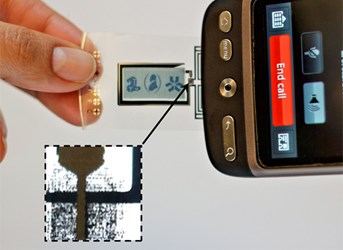Negar Sani Solved The Printed Diode Riddle

For thirteen years, the mystery remained unsolved, but now Negar Sani, a PhD student at the Laboratory of Organic Electronics, Linköping University, Campus Norrköping, succeeded in explaining how a printed diode can operate in the GHz band. The diode represents the missing link between mobiles and printed labels.
In a paper published in PNAS, the Proceedings of the National Academy of Science in the United States of America, has one thirteen year old mystery that involved a wide range of researchers at Linköping University as well as Acreo Swedish ICT finally been resolved.
This article presents a diode in printed electronics working in the GHz band, which opens a new opportunity to send signals from the mobile phone, for example, printed electronic labels. The energy from the radio signal is collected and used to switch the label display. Diode printed means that it is both cheap and easy to manufacture.
- This means we can supply printed electronics in the Internet of Things - Internet of Things - using conventional mobile phones. This opens up new communication possibilities, says Negar Sani, a PhD student at the Laboratory of Organic Electronics, Linköping University.
The diode works, scientists have known for a long, but not how and why.
Petronella Norberg at Acreo Swedish ICT la 2001 a silicon wafer in a mortar, grind it down and made a silicon paste, which she then used as ink in the printing press. She got a workable printed diodes - the electronic key component including converts AC power to DC power. But the diode only worked up to 1 MHz and a direct application did not.
At Acreo Swedish ICT then worked a research team for several years, funded by the British De La Rue, with developing both the diode as new printing pastes. With a printing paste containing transition metal niobium, in the form of niobsilicid, NbSi2, printed on top of silicon paste they got it all work even at GHz.
- The result meant a world record for printed diodes and we could also manufacture a demonstrator for De La Rue where the signal from the mobile phone was used to activate a printed display. We had shown that it was possible to link paper with the internet, says Göran Gustafsson, Department Manager at Acreo Swedish ICT.
But what about the diode worked knew they still do not.
Negar Sani has now taken the last crucial step towards solving the mystery, with support from both Professors Magnus Berggren and Xavier Crispin as a university lecturer and project leader Isak Engquist and by a number of people at Acreo Swedish ICT. The results of Negar Sani work showed that this must involve tunneling effects, phenomena in quantum physics that allows particles to bypass obstacles. In this case formed nano-thin films (1-2 nm) around the micrometer-sized grains of silicon where the current between the anode (aluminum) and cathode (silver and coal) make it through, but only in one direction.
13 years of work received its explanation, an explanation that the editors of PNAS finally approved, after more than five months of intense scrutiny by experts from various fields.
- This is the longest project I worked on. What research funder wants to wait 13 years for a publication? Without industry, in this case British De La Rue, we would not have gotten this far. Now begins the printed electronics get the same performance as traditional electronics and this is yet another example of the fruitful combination of our research, development within Acreo and the needs of the industry, says Magnus Berggren, Professor of Organic Electronics at Linköping University.
Source: Linköping University
